Index • FIDE 1948-1990 • Pre-FIDE • Highlights • Best games • News/Feedback • Gifts • Site map
World Chess Championship
|
||
The fifth title match between Kasparov and Karpov saw the 24 game match split between 12 games in New York City and 12 in Lyon. There would be fewer games in New York if one player gained a commanding lead.
At the time of the match, Kasparov was 27 years old and rated 2800. Karpov was 39 years old and rated 2730.
The prize fund was 3.000.000 US$, with 5/8 to winner. If the match ended in a tie, Kasparov would retain the title with the prize shared equally.
The time control was 40 moves in 2 1/2 hours, followed by an adjournment, then 16 moves in 1 hour. Each player had three timeouts.
Kasparov's team consisted of Zurab Azmaiparashvili and Sergey Dolmatov, who were also at Seville in 1987; Mikhail Gurevich, who was at Leningrad in 1986; Giya Georgadze, who was new for the match; and Alexander Shakarov, a long time friend. Klara Kasparova served as the head of his delegation. Missing from the team was a chief trainer, which had formerly been Alexander Nikitin. Andrew Page was Kasparov's business manager.
Karpov's team was Ron Henley, Lajos Portisch, Andrei Kharitonov, Alexei Kuzmin, Mikhail Podgaets, and Igor Zaitsev. Nikolai Krogius, a psychologist by training, served as the head of his delegation.
The match arbiter was Geurt Gijssen. Frenchman Dan-Antoine Blanc-Shapira served as master of ceremonies.
Games 1-12; New York
The New York portion of the match, sponsored by Interscope, was played in the 750 seat Hudson Theater at the Hotel Macklowe. Moves were relayed on a 15 foot electronic demo board, with cordless headphones to provide commentary. Match commentators were Yasser Seirawan, Patrick Wolff, and Bruce Pandolfini.
In January, Kasparov had been forced to leave his native Baku, where he had trained for his previous matches. He confessed later that his preparation had been below that of his previous matches and recognized that Karpov was better prepared than ever.
Most observers expected the match to be close, with Kasparov winning. GM Joel Lautier of France was one of the few who gave Karpov the better chances.
The opening ceremony was held on 7 October, followed by a gala ball in the evening at Hotel Waldorf Astoria. 600 people were invited including David Dinkins, mayor of New York, who declined to attend, although Michel Noir, mayor of Lyon, attended.
Kasparov won the right to choose the colors for the first game and picked Black, to his obvious disappointment. Karpov surprised everyone by suggesting that in the event of a drawn match, the players should continue until the first decisive game.
Both players should have displayed the flag of the Soviet Union, but Kasparov chose to use the new tricolor Russian flag to show support for Boris Yeltsin. Karpov protested on the grounds that FIDE rules dictated that "miniature flags of the nations to which the players belong are to be placed on the table". Appeals jury Lim Kok An and Bessel Kok decided that there would be no flags.
The first game was played on 8 October. After the first game, the match was largely ignored by the major U.S. television networks.
Game 1 - King's Indian Defense The first game became a Saemisch Variation (5.f3), an opening which had not been seen in previous matches. Kasparov equalized easily and the game was drawn after 30 moves.
Game 2 - Ruy Lopez The Zaitsev Variation was last seen in game 16 of the 1986 match. On the 25th move, Kasparov sacrificed a bishop.


|
| Game 2 : Kasparov - Karpov |
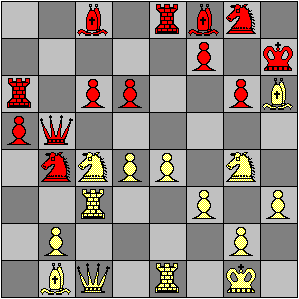
|
| after 25.Be3-h6(xP) |
|
|
One commentator announced that this was a blunder, but Kasparov had seen further. The game was an impressive victory for Kasparov, who now led 1.5-0.5.
Karpov used a timeout after game 2.
Game 3 - King's Indian Defense The opening became a Classical Variation (5.Nf3), which had not been seen in previous matches. On the 9th move, Kasparov sacrificed the exchange. On the 15th move, Kasparov thought for 40 minutes, then sacrificed his queen for rook and knight.
| Game 3 : Karpov - Kasparov |
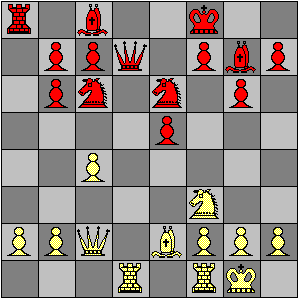
|
| after 16...a7-b6(xN) |
|
|
As compensation, Kasparov had bishop, knight, and pawn for a queen. Karpov returned the queen on his 24th move. Kasparov sealed his 41st move. The game was drawn before the next time control reached.
Game 4 - Ruy Lopez Game 4 followed the second game until Black's 15th move, and then followed games 14 and 16 of the 1986 match, until Karpov varied on his 17th move. The game was adjourned, but Karpov offered a draw before resumption, which Kasparov accepted.
Kasparov took a timeout after game 4.
Game 5 - King's Indian Defense The opening followed the third game, but Kasparov did not repeat his sacrificial line, instead varying on his 7th move. An unexciting game was agreed drawn before the first time control.
Game 6 - Ruy Lopez Karpov varied from game 4 with 9...Nd7. Kasparov sacrificed a pawn on his 25th move. The game was adjourned, with Karpov still having an extra pawn. Kasparov offered a draw before resumption, which Karpov accepted.
Game 7 - King's Indian Defense The opening followed the fifth game, with Kasparov varying on 8th move. Kasparov blundered on his 27th move and lost a pawn.

|
| Game 7 : Karpov - Kasparov |
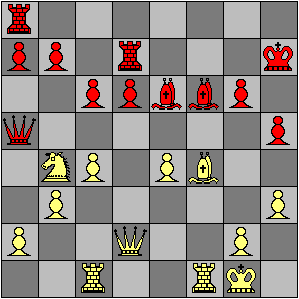
|
| after 27...Qd8-a5? |
|
|
The game was adjourned, but Kasparov resigned before resumption. Kasparov said later that this was the worst blunder of his career. The match was equal at 3 1/2 points each.
Game 8 - Ruy Lopez The opening followed the sixth game, with Kasparov varying on move 12. He developed a K side attack, but Karpov defended accurately.
A few moves before the time control, Kasparov sacrificed a pawn. The game was adjourned in a Q+R endgame with Karpov a pawn up and having two disconnected passed pawns on the queenside. Kasparov managed to hold the position when the game was resumed and it was drawn on the 84th move.
Although having battled for two days, neither player wanted to use a timeout and the ninth game was played the next day. Both players seemed extremely tired.
Game 9 - Gruenfeld Defense The opening followed game 11 of the 1987 match until Karpov varied on his 7th move, avoiding the Seville variation. Karpov had the better position, but blundered on the 32nd move by losing a pawn unnecessarily. He said later that he played his intended line out of sequence. Avoiding any risk, Kasparov returned the pawn a few moves later and the game was agreed drawn.
Game 10 - Petrov Defense Kasparov avoided variations played in several previous matches by playing 3.d4. The game was an 18 move draw which angered the spectators, some of whom had paid 100 US$ for the best seats. Since each game was worth 125.000 US$, the spectators expected more from the players.
Game 11 - King's Indian Defense The opening followed game 5 until Kasparov varied with 7...exd4. Kasparov sacrificed the exchange on his 13th move.
| Game 11 : Karpov - Kasparov |
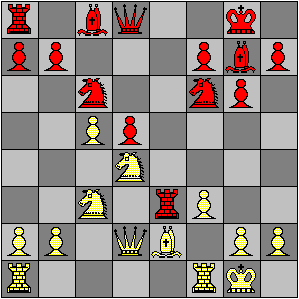
|
| after 13...Re8-e3(xB) |
|
|
He built a kingside attack, then sacrificed bishop and rook for perpetual check and a draw.
Game 12 - Ruy Lopez The last game of the New York leg was played on 7 November. The opening followed game 8 until Kasparov varied with 12.Na3. On his 28th move, in a better position, Kasparov uncharacteristically backed off from a kingside attack. Karpov gained an advantage, but Kasparov complicated the position and the game was drawn a few moves before the time control.
At midpoint, the match was tied 6-6. There had been only two decisive games in New York.
A press conference by both players after game 12 was cancelled by Kasparov. Karpov gave a press conference alone and repeated his claim that the 1984 match would never have been stopped without the permission of Kasparov.
Games 13-24; Lyon
The match moved to Lyon after game 12. Lyon is the second largest city in France and one of the country's gastronomic centers The two players took the same flight from New York a few days before continuing in Lyon.
The Lyon leg of the match was played in the Palais des Congres. With space for 900 spectators, it was often sold out.
The opening ceremony was hosted by Mayor Michel Noir. Bachar Kouatly, vice-president of the GMA, was the main organizer. The match was televised by the main French station TF1, which broadcast 14 programs of 45 minutes.
The match continued with the 13th game on 26 November.
Game 13 - Gruenfeld Defense The opening followed game 9 until Kasparov varied with 8...O-O. Karpov sacrificed the exchange on his 20th move, but Kasparov returned the material a few moves later to avoid giving White too much counterplay. The game was adjourned but agreed drawn before play continued.
Game 14 - Scotch Game The 14th game marked the first time that a Scotch had been seen in a world chess championship since the 1892 Steinitz-Chigorin match. The players castled on opposite wings and each launched an attack against the opponent's king.

|
| Game 14 : Kasparov - Karpov |

|
| after 22...Ne4-c3 |
|
|
After a series of counterblows, the position became equal and a draw was agreed after adjournment.
Game 15 - Gruenfeld Defense The opening followed game 13 until Karpov varied with 9.Nf3. Karpov had the better game, but failed to see a strong line and the game was agreed drawn after 33 moves. It was the eighth consecutive draw.
Game 16 - Scotch Game Kasparov played the Scotch again as in game 14 and Karpov varied with 8...Nb6. After a few more moves, Kasparov had a clear advantage when Karpov sacrificed a pawn in search of complications. Kasparov held the pawn, but Karpov resisted and Kasparov missed a clear win when he grabbed an exchange a few moves before adjournment.
Karpov continued to present problems in a difficult technical endgame. On move 64, the players reached a position where the 50 move rule became the dominant consideration.
The game was adjourned again with Kasparov sealing his 89th move. His team found the win before the game was resumed two days later. Karpov resigned on his 102nd move. The string of draws was finally broken and Kasparov led 8.5-7.5.
Game 17 - Gruenfeld Defense The opening followed game 15 until Kasparov varied with 9...Bg4. Kasparov never got into the game and Karpov won convincingly.

|
| Game 17 : Karpov - Kasparov |
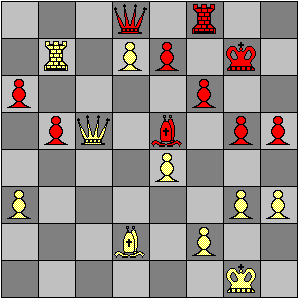
|
| after 40.Rc7-b7 1-0 |
|
|
The match was again even.
Game 18 - Ruy Lopez Kasparov switched back to the Lopez, which had not been seen since game 12. Karpov varied with 13...Nb6 and gave up a pawn on his 18th move, which was all in his analysis. Kasparov played 21.Qc4 and Karpov thought for more than one hour.
| Game 18 : Kasparov - Karpov |
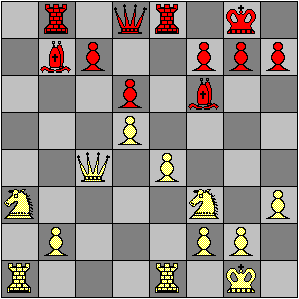
|
| after 21.Qb4-c4 |
|
|
Karpov continued to struggle a pawn down until adjournment, and resigned during the second session. He used his second timeout for the 19th game.
Game 19 - King's Indian Defense The King's Indian had not been seen since eleventh game. Kasparov played 7...c6 for the first time and the game became the only King's Indian Defense where Karpov closed the center.
Most spectators were surprised when the following position was agreed drawn, after a proposal by Kasparov. Black seems to be winning after 40.Qb2 Qa7 41.Qb6 Qa4.

|
| Game 19 : Karpov - Kasparov |
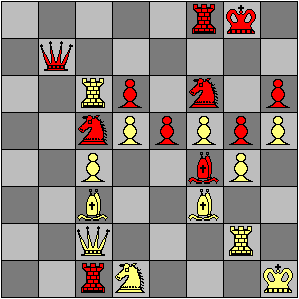
|
| after 39...Ra1-c1 1/2-1/2 |
|
|
Boris Spassky, during a press conference before his 1992 match with Fischer, was asked if he agreed with Fischer's opinion that the Kasparov-Karpov matches had been prearranged. He answered
That's a very serious question, thank you. I can only speak about my personal experience during the last match at Lyon. In particular, the 19th game. In that game, the draw was agreed on the 38th move, and Kasparov had 15 minutes for his last moves in a winning position. I became suspicious, I got angry, and I swept the pieces from the board.[...]
I was commenting on the match for the public and just before the players agreed to the draw, I was saying, "OK, it's simple. Kasparov is probably going to win this game." I was therefore very shocked at what happened.
After the game Kasparov tried to explain what had happened. His explanation was not sufficient for me.
Spassky has a reputation of being a gentleman, so his suspicions should cause some concern. Why would the two players want to prearrange the result of a game? One can only speculate. Kasparov later excused the draw "on account of enormous fatigue".
Game 20 - Ruy Lopez Karpov returned to the Zaitsev variation, last seen in game 4. Kasparov varied with 18.Rae3, sacrificed a pawn, then sacrificed a bishop, and with all of his pieces trained on Karpov's king, won the game with a spectacular attack.

|
| Game 20 : Kasparov - Karpov |
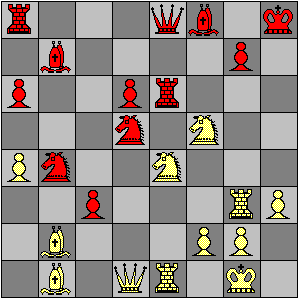
|
| after 27.Nh6-f5 |
|
|
Kasparov now led 11-9 and needed only one point in the last four games to retain the title.
Game 21 - King's Indian Defense Karpov returned to the Saemisch which had not been seen since the first game of the match. Kasparov varied with 6...e5. Karpov inexplicably played 17.Bd3-c2 followed by 18.Bd3, giving up two tempi.
Kasparov played the middle game imprecisely, sacrificed a pawn to open up a line on White's king, and the game was adjourned with Karpov having an advantage. In his book on the match, Kasparov wrote, "The adjourned position was extremely difficult for me. Even now I do not know its correct evaluation. As Dolmatov said, this ending demonstrated human helplessness in the face of chess." When the game resumed, Karpov sacrificed an exchange to create a dangerous passed pawn. Kasparov played a counter sacrifice and both players queened a pawn.
Karpov was unable to find shelter for his king and the game ended in a draw after 86 moves. After game 21, Kasparov led 11.5-9.5 and needed one more draw in the three remaining games to keep the title.
Karpov used his third timeout for the 22nd game, Saturday, 22 December. The organizers were not happy, because this was the day when they expected to sell the most tickets. There was no game on Monday, 24 December, because of Christmas Eve when a 'technical timeout' was granted by Campomanes. The match resumed on 26 December.
Game 22 - Ruy Lopez The players repeated the opening from game 4 until Karpov varied with 18...Bxd5. Karpov sacrificed two pawns to create a dangerous passed pawn, but Kasparov countersacrificed a knight for a pawn to stop the counterplay. Near the end of the first session, Kasparov forced a perpetual check and was assured of keeping the title for another three years.
Game 23 - King's Indian Defense The opening followed game 21 until Kasparov varied with 8...Qh4+. Kasparov sacrificed a piece to stop White's kingside attack, but Karpov killed all counterplay to win in 29 moves.


|
| Game 23 : Karpov - Kasparov |
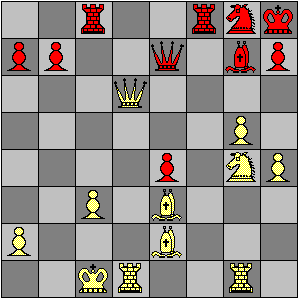
|
| after 27.Qd5-d6 |
|
|
Karpov needed to win the last game to split the prize money.
Game 24 - English Opening For the first time in the match, Kasparov did not play 1.e4. He won a pawn and, in a winning position, offered a draw. He admitted afterwards that he had only been playing for a draw. The difference between a draw and a loss in this game was worth 375.000 US$ plus the Korlov jewel.
Black did not win a single game in the match. Karpov played only 1.d4, which Kasparov answered exclusively with the King's Indian and Gruenfeld Defense. Kasparov played only 1.e4, except for the last game.
The players held a press conference on 2 January 1991. Kasparov said after the match that the organization had been more professional at New York than at Lyon. There was too much attention in Lyon to the 'spectacle' and not enough to the chess.
Most observers expected that the 1993 match would be between the same players.
|
WCC Index |
Results |
|
Previous |
Next |